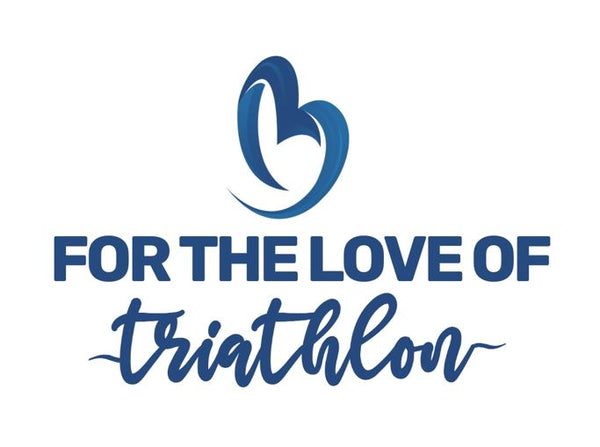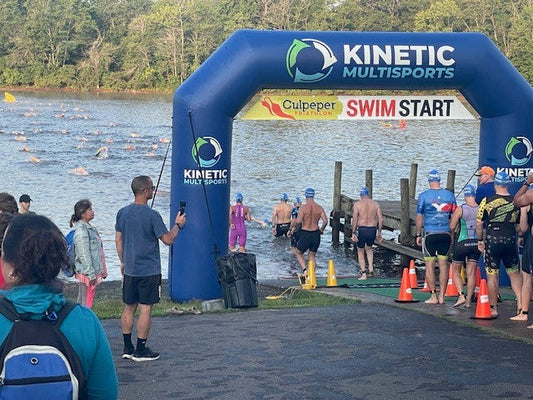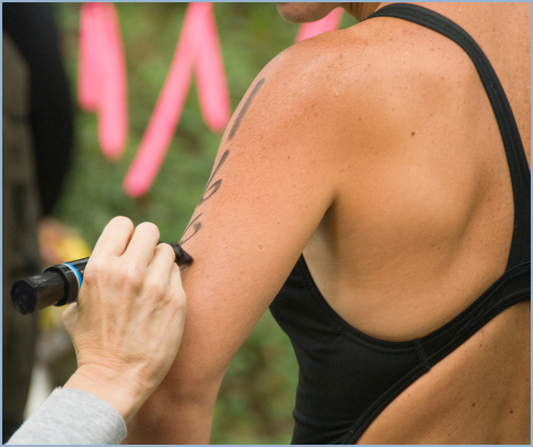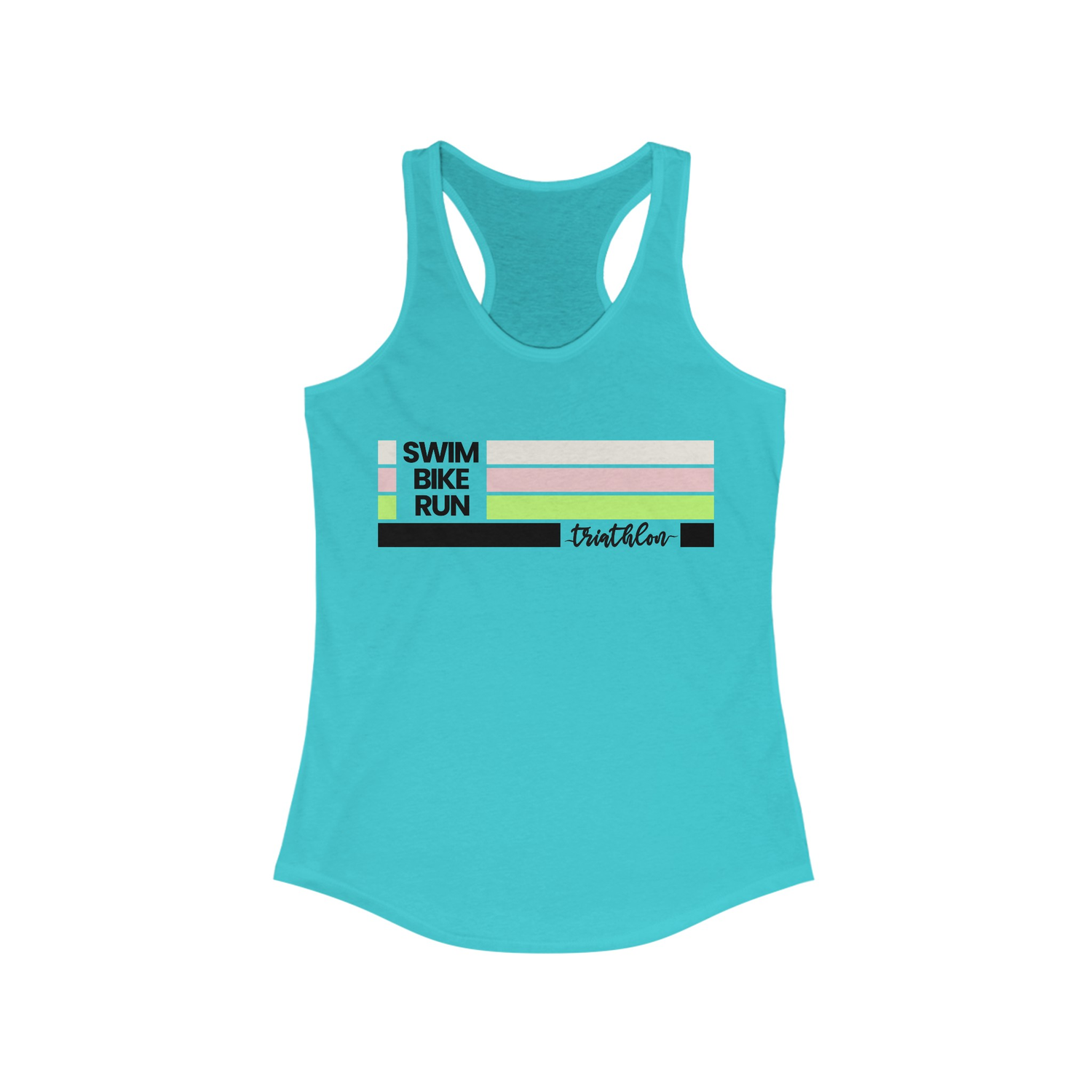Thinking about doing a triathlon?
Check out this guide with triathlon tips for beginners.
In case this is the first time visiting my site or haven’t checked out the “Our Story” page... Hi! I'm Brooke. A wife. A mom. A professional. A dog mom. A daughter. A friend. And a Triathlete.
So far, I’ve completed 44 triathlon races, including 2 IRONMAN distance and 8 - 70.3 distance races. While I am still training and racing, I am also constantly trying to stay in the “athlete” mindset while I juggle life. Through my various racing experiences, I’ve gathered a lot of “intelligence” though it still surprises me to find myself having all the “first timer” nerves. I've learned to embrace these feelings, because I feel a healthy amount of fear/discomfort is a good thing in life to challenge you.
I recently attended my first triathlon as a spectator. Thanks to my fave multisport group, Kinetic Multisports, I set-up a tent at their season opening race at Lake Anna (Virginia) to sell For The Love Of Triathlon clothing. It was a blast cheering so many triathletes and first time racers through the finish chute. Since race days are so much fun, I thought it would be helpful to put together a “first timers” triathlon guide to help those just starting out in the sport.
*Author's note: As you read through this, you may hear the cha-ching of a cash register ringing in your ears. And you aren’t wrong. Triathlon can be an expensive sport, and I want to give that warning in advance. For most of us, the fun and challenge far outweighs the expense, so we bite the bullet and hand over our credit cards.
This triathlon first-timers guide is broken down into the following: About Triathlon - Distance - Training - Attire - Gear - Mindset - Race Day - Weather
1. ABOUT TRIATHLON
3. TRAINING
- Access to a pool at least 2x per week - Community pools are a great place to get your laps in. You can do a google search for Tri Clubs in your area to participate in their group swims or a “Masters” group. “Masters” is basically the equivalent of a swim team for adults, don’t let it fool you (like it did me) into thinking everyone is an Olympic hopeful. If you want to practice an open water swim before your race, check out open water swim practices at your race location or with your tri club. There are usually lots of options if you search for it.
- Bike or access to a gym with stationary bikes - you will need an actual bike for race day. If you borrow one, make sure you get some outdoor training on it to work on your bike handling skills, like turning and reaching for your water bottle). It’s ok to get a lot of your time done on a stationary bike, because that builds your endurance. I started cycling as an indoor cycle instructor, which really helped my endurance.
- If you are new to cycling, your butt is gonna hurt. A lot. Yes, you do get used to it and it does go away but the first few weeks will be rough. Also, you might get “saddle sores” where a specific area rubs. They hurt like hell. They can be prevented and treated with creams.
- Locate trails or reduced car traffic roads near you that other cyclists like to ride. It’s important to learn some basic rules of the road (staying to the right at all times except when passing another cyclist) as well as bike handling skills, like reaching for your water bottle and cornering.
- Cycling shoes - If you want to clip into your pedals, you will need specific shoes, pedals and cleats. If you are trying out triathlon with a sprint or Olympic, you can get away with riding in tennis shoes. Cycling shoes are recommended for the half and full triathlon distances. The advantage of “clipping in” is that it allows you to get a full push/pull from the entire pedal stroke equaling more power and going faster. It does take some time to get used to clipping in, so be sure to practice outside on grass. It’s totally normal to have a few falls when you are practicing.
- Tri Clubs are a great resource for training and camaraderie. Be sure to do a search for tri clubs in your area so you can become a member and participate in group workouts.
- Music - Headphones are not allowed on race day. It’s a safety concern, so try to practice as much as possible without them. It helps you get comfortable with listening to yourself breathe, as well as the mental load of your many, many thoughts.
4. ATTIRE
I’ve broken this section down into two parts - attire for training and attire for race day since they are different and left off some obvious things such as running shoes.
- Training:
- Swimsuit, goggles, and cycling shorts - It’s helpful to invest in a good pair of padded cycling shorts. I prefer the Zoot brand, simply because they’ve held up the longest for me AND the padding hits in the right spots. There are a ton of good brands out there. They come in all different lengths on your thigh (women) and different style grips on your thigh so they don’t slide up (to avoid those rub spots).
-
Wetsuit - always a conversation topic amongst triathletes, the wetsuit is usually optional. Being in the U.S. mid-atlantic region, a wetsuit has always been a “nice to have but not needed” kind of thing because water temperatures aren’t usually super low. I didn’t get one until my third or fourth season racing. That being said, I am a strong-ish swimmer and absolutely love open water swimming. If swimming is not your strength, you may find peace of mind having the extra buoyancy with a wetsuit. My preference is sleeveless, simply because I don’t like my shoulders feeling constricted. Full sleeves are probably better for those in other regions where the water temperatures can be frigid. *Before investing in a wetsuit, ask around to see if you can borrow or rent one if you think it'll be needed for race day.
- Race Day:
- Tri Suit - The key for race day is to a) eliminate drag in the water b) be aerodynamic on the bike (nothing flapping in the wind) and c) be comfortable on the run. There are two options for race day attire - a one piece tri suit or a two piece. Usually called a “tri kit” , this triathlon specific race gear is made of lightweight fabric that dries easily after swimming and doesn’t retain water. It almost feels like a second skin. The shorts have a very thin pad for biking so it doesn’t retain water. Some people will get tri shorts and swim in a sports bra, then throw on a t-shirt to bike and run. That is totally ok if it makes you feel more comfortable. (Btw, I've got some cool tee's and tanks in my shop! My fave is the Focused On The Finish Line).
- The benefits of a one piece tri suit is that it stays in place and is minimal drag. It will likely have a zipper up the front chest and might even have sleeves to cover your shoulders (minimize sunburn). The main negative is the tedious unzipping to use the bathroom.
- The benefits of a two piece is easy bathroom use. A two piece allows people who are larger up top (or vice versa) to mix and match top/bottom sizes. Sometimes the top can ride up when running, so finding the right one can be tough. I sewed snaps on mine, so the top snaps to the bottom (front only at my hip sockets) to keep it in place.
Believing that you can do it, is the first step. You are here, reading this, so you can check that box. Next is to believe that if you put in the work, you’ll be able to achieve the goal. Once you subscribe to that thought, follow the plan and you’ll be able to look back over your training to feel confident.
Let ‘trusting the process’ bring you some stress relief. Start using a mantra that you will repeat on race day, especially when times get tough. “I can and I will” or “I can do hard things” or “what doesn’t kill me makes me stronger”. If a mantra doesn’t speak to you, try a song. In the past, I’ve been partial to “Headstrong” by Trapt and “Titanium” by Sia.
6. RACE DAY
Preparing for race day takes a lot of focus and organization. Once you are a week out from your race, check out my article on being RACE DAY READY.
7. WEATHER
One of the number one things you will learn as a triathlete, is to focus your energy on what you can control. Your training, your fuel, your sleep… weather is totally outside of your control. Despite it being so frustrating to have a rainy race day, we can be prepared. Check out this blog post for being prepared for a rainy race day.
I sincerely hope this triathlon first timers guide helps you feel better prepared for the sport of triathlon. Always remember that every triathlete you see, was a first-timer at one point, so we’ve all been there and we absolutely love seeing new faces tackle the sport. It takes a lot of dedication to learn the sport, as with anything new, but it’s a lot of fun. I hope you enjoy the ride. Let me know how it goes in the comments.
- Brooke

^Crossing the finish line is the sweetest moment you'll always savor!









